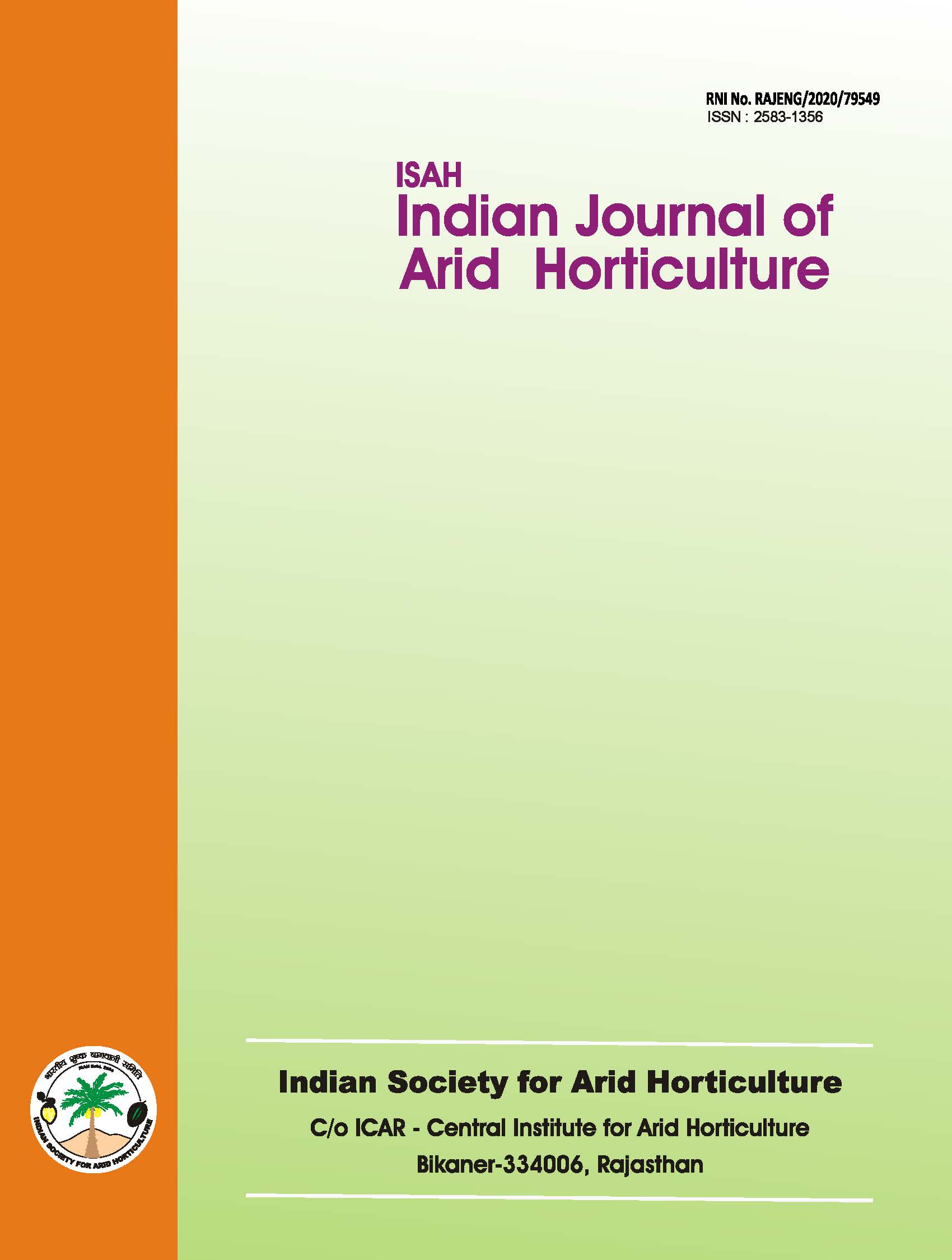Impact assessment of integrated pest management technology for ber fruit fly (Carpomya vesuviana Costa) under arid and semi-arid regions of Rajasthan
DOI:
https://doi.org/10.48165/ijah.2025.7.1.9Keywords:
Ber, front line demonstrations (FLDs), fruit fly,, integrated pest management (IPM), methyl eugenol trap, net returnAbstract
The adoption of IPM approaches in ber resulted in a lower incidence of fruit
damage, with a 65% mean reduction compared to farmer’s practices. Mean
higher yield of 111.2 q/ ha was recorded in the demonstration compared to 77.84
q/ ha in farmer’s practice, representing a 42.86% increase. This has resulted in higher mean net returns of Rs. 1,79,640/- ha with a Benefit Cost Ratio (BCR) of 3.76 in the demonstration, compared to Rs. 1,08,248/- ha in farmer’s practice with a BCR of 2.72. The current study’s findings clearly indicated that using IPM technology against the ber fruit fly was more effective and economical than conventional methods.
Downloads
References
Anonymous. (2018–2019). National Horticulture Board (NHB), Ministry of Agriculture & Farmers Welfare, Government of India. http://www.nhb.gov.in
Butani, D. K. (1979). Pests of sub-tropical fruits (Ber). In Indian Insects and Fruits (p. 173). Periodical Expert Book Agency.
Karuppaiah, V. (2014). Biology and management of ber fruit fly, Carpomyia vesuviana Costa (Diptera: Tephritidae): A review. African Journal of Agricultural Research, 9(16), 1310–1317.
Kibira, M., Affognon, H., Njehia, B., Muriithi, B., Mohamed, S., & Ekesi, S. (2010). Economic evaluation of integrated management of fruit fly in mango production in Embu County, Kenya. African Journal of Agricultural and Resource Economics, 10, 343–353.
Kumar, C., Singh, D., Choudhary, M. K., Tetarwal, A. S., & Kuri, B. R. (2024). Performance and impact of front line demonstration of papaya in Western Rajasthan. Annals of Arid Zone, 63(1), 67–71.
Lakra, R. K., & Singh, Z. (1984). Calendar of losses due to ber fruit fly, Carpomyia vesuviana Costa (Diptera: Tephritidae) in different Ziziphus spp. in Haryana. Indian Journal of Entomology, 46, 261–264.
Muriithi, B. W., Affognon, H. D., Diiro, G. M., Kingori, S. W., Tanga, C. M., Nderitu, P. W., Mohamed, S. A., & Ekesi, S. (2016). Impact assessment of Integrated Pest Management (IPM) strategy for suppression of mango-infesting fruit flies in Kenya. Crop Protection, 81, 20–29.
Nyangau, P., Muriithi, B., Irungu, P., Nzuma, J., & Diiro, G. (2017). Assessing the impact of integrated pest management (IPM) technology for mango fruit fly control on food security among smallholders in Machakos County, Kenya. In 91st Annual Conference, Royal Dublin Society, Dublin, Ireland.
Patel, M. M., Jhajharia, A. K., Khadda, B. S., & Patil, L. M. (2013). Frontline demonstration: An effective communication approach for dissemination of sustainable cotton production technology. Indian Journal of Extension Education, 21, 60–62.
Prasad, D., Prakash, V., Meena, R. S., & Bairwa, S. K. (2022). Performance of chickpea (Cicer arietinum, L.) front line demonstrations in North West Plain Zone of Rajasthan. Indian Journal of Agricultural Sciences, 92(2), 109–112.
Sagar, R. L., & Chandra, R. (2004). Front line demonstration on sesame in West Bengal. Agriculture Extension Review, 16(2), 7–10.
Samui, S. K., Maitra, S., Roy, D. K., Mandal, A. K., & Saha, D. (2000). Evaluation of front-line demonstration on groundnut. Journal of the Indian Society of Coastal Agricultural Research, 18(2), 180–183.
Singh, B., & Sharma, A. K. (2018). Impact of front-line demonstrations on yield, knowledge adoption and horizontal spread of cumin crop in arid zone. International Journal of Seed Spices, 8(2), 32–35.
Tetarwal, A. S. (2021). Impact of front-line demonstrations on productivity of cumin in arid Kutch of Gujarat. Annals of Agricultural Research, 42(3), 325–331.

